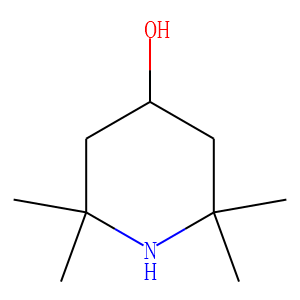| Reference | [1]. Li, C., Xue, L., Cai, Q., Bao, S., Zhao, T., Xiao, L., Gao, G., Harnoode, C. and Dong, A., 2014.<br />
Design, synthesis and biocidal effect of novel amine N-halamine microspheres based on 2, 2, 6, 6-tetramethyl-4-piperidinol as promising antibacterial agents.<br />
Abstract: Novel superior antibiotics, i.e. amine N-halamine microspheres based on 2,2,6,6-tetramethyl-4-piperidinol, were first synthesized by the aid of the radical copolymerization for deactivating pathogenic bacteria. The effects of copolymerization period on particle size and copolymer component of the products were elucidated. The oxidative chlorine content in amine N-halamine microspheres was determined by the modified iodometric/thiosulfate technique. The effect of chlorination period on oxidative chlorine content was investigated as well. Bactericidal behaviour of the products on bacterial strain was tested by selecting Staphylococcus aureus (S. aureus) and Escherichia coli (E. coli) as model pathogenic bacteria. Antibacterial assessment, including the plate counting technique, zone of inhibition study, and antibacterial kinetic test, demonstrated that amine N-halamine microspheres exerted powerful bactericidal capability. Effects of the contacting period, particle size, and oxidative chlorine content on antimicrobial activity were also established. High stability of amine N-halamine microspheres as a function of soaking period was finally confirmed. Such a systematic investigation of amine N-halamines provides us a novel idea of making them promising candidates for deactivating bacteria and even in disease control.<br />
RSC Advances, 4(88), pp.47853-47864.<br />
<br />
[2]. Berliner, L.J., 1970.<br />
Refinement and location of the hydrogen atoms in the nitroxide 2, 2, 6, 6-tetramethyl-4-piperidinol-1-oxyl.<br />
Acta Crystallographica Section B: Structural Crystallography and Crystal Chemistry, 26(8), pp.1198-1202.<br />
<br />
[3]. Li, C., Hou, J., Huang, Z., Zhao, T., Xiao, L., Gao, G., Harnoode, C. and Dong, A., 2015.<br />
Assessment of 2, 2, 6, 6-tetramethyl-4-piperidinol-based amine N-halamine-labeled silica nanoparticles as potent antibiotics for deactivating bacteria.<br />
Abstract: Novel potent antibiotics, amine N-halamine-labeled silica nanoparticles (ANHLS NPs) based on 2,2,6,6-tetramethyl-4-piperidinol (TMP), were skillfully synthesized via the encapsulation of silica nanoparticles with amine N-halamine polymer for effective killing pathogenic bacteria. The particle size and coating thickness of amine N-halamine of ANHLS NPs were well controlled by tuning size of silica NPs and polymer encapsulation period, respectively. Effect of chlorination time on the oxidative chlorine content in ANHLS NPs was well elucidated by the aid of the modified iodometric/thiosulfate technique. Antimicrobial action of the ANHLS NPs on bacterial strain was evaluated using Staphylococcus aureus and Escherichia coli as model pathogenic bacteria. Bactericidal assessment showed that the ANHLS NPs exerted powerful bactericidal capability toward both two model bacteria. Time-kill assay demonstrated the significance of the oxidative chlorine content and contact time on antibacterial behavior. Size effect experiment displayed the decisive role of the size in controlling the biocidal activity. Plausible antibacterial mechanism of the ANHLS NPs against pathogenic bacteria was also discussed. Such a systematic investigation of the ANHLS NPs provides us a novel idea of making them the promising candidates for deactivating bacteria or even disease control.<br />
Colloids and Surfaces B: Biointerfaces, 126, pp.106-114.<br />
<br />
[4]. Chen, Y., Wang, Y., Zhang, Q., Yang, C. and Han, Q., 2019.<br />
Preparation of silicone containing 2, 2, 6, 6‐tetramethyl‐4‐piperidinol‐based N‐chloramine for antibacterial polyethylene via interpenetration in supercritical carbon dioxide.<br />
ABSTRACT: Functionalization of polyethylene (PE) with powerful biocides through a friendly and efficient procedure is necessary to obtain extended applications. A novel CO2-philic 2,2,6,6-tetramethyl-4-piperidinol (TMP)-based N-chloramine silicone was synthesized via Pt-catalyzed silane alcoholysis between the SiH of poly(methylhydrosiloxane) and OH of TMP and followed by chlorination of amine NH originating from TMP to NCl. The TMP-based N-chloramine silicone was interpenetrated into PE using supercritical carbon dioxide (scCO2) as working solvent. It was shown that the thickness of the TMP-based N-chloramine silicone layer on PE can be easily controlled by the interpenetration pressure, reaching a maximum value of 70 nm at 28 mp. The synthetic procedures and the interpenetration results were characterized by Fourier transform infrared, scanning electron microscopy, and X-ray photoelectron spectroscopy. In contrast with pristine PE that did not show biocidal ability, the TMP-based N-chloramine silicone modified PE imparted powerful antibacterial abilities, exerting total kills of both Staphylococcus aureus and Escherichia coli of ~107 cfu mL−1 in 30 min. The biocidal functionality was durable toward washings, storage, and ultraviolet exposure and the recoverability of lost chlorines was good. The interpenetration in scCO2 tactic provides an environmentally friendly and universal approach to functionalize inert substrates due to no needs of harmful solvent and chemical linkages with biocides. © 2019 Wiley Periodicals, Inc. J. Appl. Polym. Sci. 2019, 136, 47614.<br />
Journal of Applied Polymer Science, 136(23), p.47614.<br />
<br />
[5]. Anastassopoulou, J.D. and Rakintzis, N.T., 1984.<br />
Reaction of OH Radicals with 2, 2, 6, 6-tetramethyl-4-piperidinol-1-oxyl (TEMPOL) in Aqueous Solutions.<br />
Zeitschrift für Physikalische Chemie, 141(1), pp.53-58.
|

